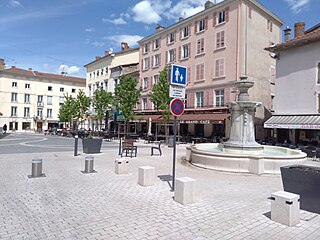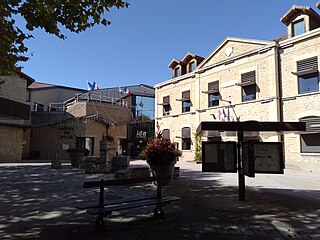Related Research Articles

CS Bourgoin-Jallieu is a French rugby union club competing in the third level of the French league system, Nationale.

La Tour-du-Pin is a subprefecture of the Isère department in the Auvergne-Rhône-Alpes region in Southeastern France.

The arrondissement of La Tour-du-Pin is an arrondissement of France in the Isère department in the Auvergne-Rhône-Alpes region. It has 136 communes. Its population is 302,380 (2016), and its area is 1,543.1 km2 (595.8 sq mi).

The arrondissement of Vienne is an arrondissement of France in the Isère department in the Auvergne-Rhône-Alpes region. It has 113 communes. Its population is 212,383 (2016), and its area is 1,489.7 km2 (575.2 sq mi).

Bourgoin-Jallieu is a commune in the Isère department in the region of Auvergne-Rhône-Alpes in France. The city had 28,834 inhabitants in 2019 and lies 35 kilometres east-southeast of Lyon. It was formed by the merger of the former communes Bourgoin and Jallieu in 1965.

Charles Jean Julien Depéret was a French geologist and paleontologist. He was a member of the French Academy of Sciences, the Société géologique de France and dean of the Science faculty of Lyon.

L'Isle-d'Abeau is a commune in the Isère department in the Auvergne-Rhône-Alpes region in Southeastern France. It lies 35 kilometres southeast of Lyon. It is part of the urban unit (agglomeration) of Bourgoin-Jallieu, as well as of the larger functional area of Lyon.

La Bâtie-Montgascon is a commune in the Isère department in the Auvergne-Rhône-Alpes region of south-eastern France.

Les Avenières is a former commune in the Isère department in the Rhône-Alpes region of south-eastern France. On 1 January 2016, it was merged into the new commune of Les Avenières-Veyrins-Thuellin.

Les Abrets is a former commune in the Isère department in the Auvergne-Rhône-Alpes region of southeastern France. On 1 January 2016, it was merged into the new commune of Les Abrets-en-Dauphiné, of which it became a delegated commune.

Saint-Quentin-Fallavier is a commune in the Isère department, and the Auvergne-Rhône-Alpes region, in southeastern France.

The Bourbre is a 72.3 km (44.9 mi) long river in the Isère and Rhône departments in central eastern France. Its source is in Burcin. It flows generally north-northwest. It is a left tributary of the Rhône, into which it flows at Chavanoz.

Lyon-Jean Macé station is a railway station in the 7th arrondissement of Lyon. It is situated on the Paris–Marseille railway and the Lyon–Geneva railway. The station is a part of the Lyon urban area rapid transit network. It was aimed to decongest the major stations Part-Dieu and Perrache while allowing access to the public transport of Lyon (TCL). The station began operation on 13 December 2009.
Miniopterus zapfei is a fossil bat in the genus Miniopterus from the middle Miocene of France. First described in 2002, it is known only from the site of La Grive M, where it occurs with another fossil Miniopterus species, the smaller and more common Miniopterus fossilis. M. zapfei is known from five mandibles and an isolated fourth upper premolar (P4). The fourth lower premolar is more slender than in M. fossilis and the cingulum shelf surrounding the P4 is less well-developed than in living Miniopterus. The length of the first lower molar is 1.57 to 1.60 mm.

Grenoble is the main railway station located in Grenoble, Isère, France. The station was opened on 3 January 1849 and is located on the Lyon–Marseille railway and Grenoble–Montmélian railway. The train services are operated by SNCF.
Lagrivea is a fossil genus of squirrel from the Middle Miocene of France. The single species, L. vireti, is known from three mandibles and two isolated teeth. All come from the fissure filling of La Grive L5, part of the La Grive-Saint-Alban complex in Saint-Alban-de-Roche, southeastern France. Lagrivea was a large tree squirrel with flat lower incisors and a large, triangular fourth lower premolar (p4). Each of the four cheekteeth bears a deep basin in the middle of the crown. The m3 is about rectangular in shape, but rounded at the back. Although m1 and m2 have two roots, m3 has three.
Python europaeus is an extinct python species. It lived during the early/middle miocene. The holotype is a single trunk vertebra found in France.
Communauté d'agglomération Porte de l'Isère is an intercommunal structure, centred on the cities of L'Isle-d'Abeau and Bourgoin-Jallieu. It is located in the Isère department, in the Auvergne-Rhône-Alpes region, eastern France. It was created in January 2007. Its seat is in L'Isle-d'Abeau. Its area is 245.9 km2. Its population was 106,737 in 2017.
La Grive-Saint-Alban is a geomorphological karstic site located on the territory of the French commune of Saint-Alban-de-Roche, in the Isère department. This area, long exploited for its red clay, is known since the 19th century for the richness of its fossil deposits, distributed from the Bathonian stage to the Miocene.
References
- ↑ Pérez de los Ríos, Miriam; Alba, David M.; Moyà-Solà, Salvador (August 2013). "Taxonomic attribution of the La Grive hominoid teeth". American Journal of Physical Anthropology. 151 (4): 558–565. doi:10.1002/ajpa.22297. ISSN 1096-8644. PMID 23754569.
- 1 2 "La Grive M, Bourgoin-Jallieu, La Tour-du-Pin, Isère, Auvergne-Rhône-Alpes, France". Mindat.org .
- ↑ Shufeldt, R. W. "Fossil Bones of Birds and Mammals from Grotto Pietro Tamponi and Grive-St. Alban". Proceedings of the Academy of Natural Sciences of Philadelphia. 48: 507–516.
- ↑ López-Antoñanzas, Raquel; Mein, Pierre (2011-08-24). "First detailed description of Hispanomys decedens (Rodentia) from the Middle Miocene of La Grive-Saint Alban (France)". Swiss Journal of Geosciences . 104 (2). doi:10.1007/s00015-011-0066-0. ISSN 1661-8726.
- ↑ Estes R., Hoffstetter R. (1976) Les urodèles du Miocène de La Grive-Saint-Alban (Isère, France) [The urodeles from the Miocene of La Grive-Saint-Alban (Isère, France)], Bulletin du Muséum National d’Histoire Naturelle, Sciences de la Terre 57, 297-343
- ↑ "Collection: La-Grive-Saint-Alban Bourgoin-Jallieu, La Tour-du-Pin, Isère, Auvergne-Rhône-Alpes, France". Mindat.org .
- ↑ Ivanov M. (2002) Fossil snake assemblages from the French Middle Miocene localities at La Grive (France), The 7th European Workshop of Vertebrate Paleontology. Sibiu, Romania, 2–7 July 2002, Abstracts Volume and Excursions Field Guide, 21-22